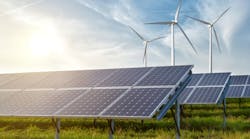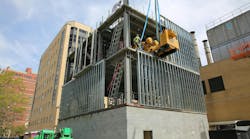With U.S. renewable energy capacity (excluding hydropower) expected to double by 2021, the firms that provide engineering, procurement, and construction (EPC) services for solar and wind projects will need to adapt to the economic realities of a changing industry. Faced with a scarcity of large utility-scale projects and shrinking profit margins, the largest firms will need to look at new opportunities or change their business models to avoid disappointing returns.
“From afar, the various firms that provide these services might appear to be indistinguishable. But some firms have carved specialized niches or developed impressive track records. In an environment in which the easy projects have been done and incentives are expiring, differentiation and know-how matter more than ever.”
The findings come from a new report researched by Bloomberg New Energy Finance (BNEF) and commissioned by CohnReznick. The report also includes a ranking of major EPC companies that have brought the largest quantity wind and solar capacity online. The rankings:
Solar Companies: SunPower, First Solar, Mortenson, and E Light Wind and Solar
Wind Companies: Mortenson, IEA, RES Americas, and Blattner
Key Findings:
- Some EPC firms that have historically focused on wind are broadening their attention to solar, which offers a more stable policy environment. Firms that can focus on smaller utility-scale solar projects (1-10MW) in states with robust incentives may find higher margins than might be gained from large-scale wind.
- Key EPCs with significant experience as general contractors have now also developed deep expertise in US renewable energy, providing their clients with knowledge of financing obstacles, development trends, and technology advancements. They are also becoming involved in areas such as permitting and securing the point of interconnection. Some EPC firms are providing their clients with financing or alternative payment methods to help get projects completed.
- EPC firms are beginning to look to other ‘adjacent’ technologies such as advanced storage.
- EPC costs have been falling as the increased scale and maturity of the US solar and wind industries are, for the most part, driving total project costs down. In some regions, competition with the oil & gas sector for resources is reversing this trend.
The report also explores how EPC firms across the country differentiate themselves through factors such as company size and financial health, geographic focus, and unique client services.
Michel Di Capua, head of analysis in the Americas, for BNEF, said: “From afar, the various firms that provide these services might appear to be indistinguishable. But some firms have carved specialized niches or developed impressive track records. In an environment in which the easy projects have been done and incentives are expiring, differentiation and know-how matter more than ever.”
Tim Kemper, co-national director of CohnReznick’s Renewable Energy Industry Practice said: “To stand out, EPC firms must offer credibility and financial stability. As the renewable energy industry continues to develop and grow, it is clear that the EPC sector will become a more critical element of the financing aspect of projects. At CohnReznick we saw an opportunity to review and analyze this segment of the industry and share the findings.”
The market for EPC services for utility-scale solar and wind is forecasted to peak at $7.2bn in 2015 before falling 28% to $5.2bn in 2016 and another 52% to $2.5bn in 2017, as a number of federal tax incentives effectively expire or decrease in those years.
The report also looks at the economics of providing EPC services. Estimated EPC prices (including component costs but excluding development costs) for photovoltaic solar projects range from $1.38/W for very large desert-based projects using thin-film modules, to $1.97/W for projects around 5MW in size in New Jersey. Labor is the most important variable cost. For wind, EPC costs (including balance of plant costs but excluding costs of turbines) range from $0.41/W in Oklahoma to $0.62/W in New England.
Jacqueline Lilinshtein, Clean Energy Economics analyst at Bloomberg New Energy Finance, said: “On the solar side, downward pressure on margins will likely continue as developers look to EPCs to absorb expected price increases caused by tariffs in Chinese panels. On the wind side, competition with the gas industry for labor and basic commodities will add additional stress.”



